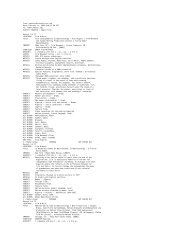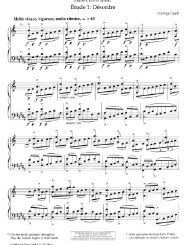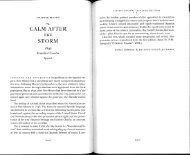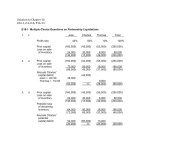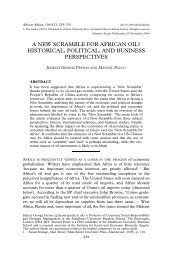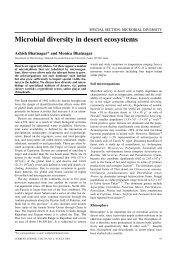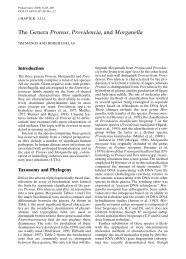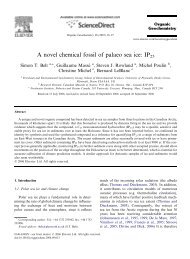Analysis by Key: Another Look at Modulation
Analysis by Key: Another Look at Modulation
Analysis by Key: Another Look at Modulation
Create successful ePaper yourself
Turn your PDF publications into a flip-book with our unique Google optimized e-Paper software.
ANALYSIS BY KEY<br />
Monotonality; <strong>Key</strong> Succession as Large-Scale Chord Progression<br />
The Beethoven and Haydn illustr<strong>at</strong>ions, where the governing linear and chordal<br />
pitch structure differs from the succession of keys, call into question a frequent<br />
analytic assumption- th<strong>at</strong> key successions are simply chord progressions writ<br />
large. This is <strong>by</strong> no means a recent notion: in the earliest stages of modern<br />
harmonic analysis, theorists <strong>at</strong>tempted to rel<strong>at</strong>e secondary keys - <strong>at</strong> least those<br />
most frequently employed - to the whole piece r<strong>at</strong>her than regarding them as<br />
separ<strong>at</strong>e and self-contained entities. Schenker praises C. P. E. Bach for<br />
conceiving of 'keys' as prolonged Stufen, drawing this inference from Bach's<br />
referring to the goals of modul<strong>at</strong>ion as scale degrees in the main key ('fifth with<br />
major third, sixth with minor third' and so on). 12 But Bach was <strong>by</strong> no means the<br />
only eighteenth-century theorist to define in this way the rel<strong>at</strong>ion between<br />
prlmary and secondary keys. Both Rameaul3 and Kirnberger do so; and<br />
Kirnberger'4 even uses Roman numerals to indic<strong>at</strong>e the scale degrees in the<br />
main key on which the new 'tonics' fall.<br />
The most beautiful formul<strong>at</strong>ion of this idea th<strong>at</strong> I know stems from Brahms,<br />
though the precise wording comes from his pupil, Gustav Jenner. In discussing<br />
his lessons in song composition, Jenner writes:<br />
The position and form of the cadences is closely bound up with the p<strong>at</strong>h of<br />
modul<strong>at</strong>ion. Here Brahms demanded the utmost restraint and consistency.<br />
In the disposition of even a very long song with extended and self-contained<br />
episodes, the main point was to express fully the primary key and to reveal<br />
its control over secondary keys through clear rel<strong>at</strong>ionships. In this way, so to<br />
speak, the sum of all the keys employed in a piece appeared like an image of the<br />
primary key in a st<strong>at</strong>e of activity. 15 [my emphasis]<br />
For me, <strong>at</strong> least, Jenner's simile conveys more truth than much technical<br />
descripiion along similar lines, largely because it suggests a difference between<br />
the intensity of a primary key activ<strong>at</strong>ed <strong>by</strong> modul<strong>at</strong>ion and the lesser intensity of<br />
a key not so activ<strong>at</strong>ed. Compare, for example, this cit<strong>at</strong>ion from the Fifth<br />
Edition of Grove's Dictionary: 'The same rules apply to key progressions which<br />
apply to any harmonic progression .... Those progressions to or from the tonic<br />
which are in themselves complete and s<strong>at</strong>isfactory within the key find an equally<br />
s<strong>at</strong>isfactory counterpart in the wider sphere of modul<strong>at</strong>ion . . .,.16 The idea is<br />
plausible because it is well expressed and partly true. But only partly. The<br />
article's main example of modul<strong>at</strong>ion in Baroque music is a chart of the key<br />
scheme of the Allemande from the Fourth French Suite. The analysis shows<br />
(correctly, I think) th<strong>at</strong> the main modul<strong>at</strong>ions are from Eb to Bb to C minor to<br />
Eb. But is VI-I a 'complete and s<strong>at</strong>isfactory' return to a tonic within the key?<br />
Hardly. Nor is the picture any better when we consult the many transient and<br />
hinted-<strong>at</strong> keys shown in the chart, for taking them into account yields a return to<br />
IfromII.l7<br />
The problem with this partly valid approach is its failure to give due weight to<br />
MUSIC ANALYSIS 6:3, 1987 299



